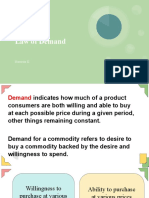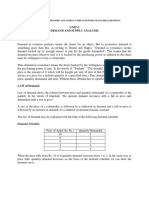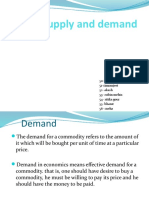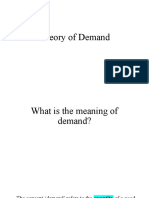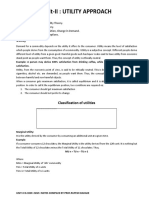Template
Template
Uploaded by
Shipra GosainCopyright:
Available Formats
Template
Template
Uploaded by
Shipra GosainOriginal Title
Copyright
Available Formats
Share this document
Did you find this document useful?
Is this content inappropriate?
Copyright:
Available Formats
Template
Template
Uploaded by
Shipra GosainCopyright:
Available Formats
Name of Institution
CAUSES AND EXCEPTIONS OF LAW OF DEMAND Presented by: SHIPRA GOSAIN NIDHI
LAW OF DEMAND
Name of Institution
Law of demand states that the amount demanded of a commodity and its price are inversely related, other things remaining constant. That is, if the income of the consumer, prices of the related goods, and tastes and preferences of the consumer remain unchanged, the consumers demand for the good will move opposite to the movement in the price of the good.
Name of Institution
Law of diminishing marginal utility: The law of diminishing marginal utility states that for every additional unit of a commodity consumed, the marginal utility derived from the consumption of that unit is falling. This is because the earlier unit has partly satisfied our want. For example, if you get the utility of 10 utils by consuming one bread and 4 utils by consuming 2 breads and 1 util by consuming three breads, then the marginal utility has fallen from 10, then 6 to 3. A rational consumer will definitely like to pay less for falling marginal utility as he consumes more and more. Income effect: Real income of a consumer is obtained by dividing his money income with the price of the commodity. If his money income remains constant, then the increase in the price of the goods will result in the fall in the purchasing power of the consumer which means that he will now be able to buy lesser quantity of the commodity. For example, if the income was Rs.100 and the price of a good was Rs.10, then he is able to buy 10 units of that good. But if the price increases to Rs.20, he is able to buy only 5 units of that good. Thus, there is an inverse relationship between price and demand.
3
Name of Institution
Substitution effect:The substitution effect is the effect that a change in the relative price of the substitute goods has on the demand for the commodity. When the price of a good falls, prices of its substitutes remain the same, it is obvious that the consumers shall now move from the consumption of that substitute to the original commodity. For example, if the prices of tea coffee remains constant and the prices of tea rises, the consumers will shift their consumption form tea to coffee. The sum total of the income effect and the substitution effect is together called the price effect. Increase in the number of the consumers: A fall in the price of the commodity leads to an increase in the demand for that commodity. At the same time, when the prices of the goods are high, only a few rich people can buy them. But when the prices fall, more consumers enter the market and increase the demand for the product as purchasing the product fall within their reach. Reverse happens in case of price rise. When the prices rise, some consumers are not able to buy the product and they leave the market. Ads a result, the demand for that commodity falls.
4
Name of Institution
Several uses of a commodity: There are some goods that can be put to a number of uses. Examples of such goods are electricity, milk etc. When the prices of such goods fall, the consumers start using them for less important purposes and hence, their demand increases. But when the prices of such goods rises, they are put to very important uses only and hence their demand falls.
Name of Institution
The law of demand does not apply in every case and situation. The circumstances when the law of demand becomes ineffective are known as exceptions of the law. Some of these important exceptions are as under. 1. Giffen goods: Some special varieties of inferior goods are termed as Giffen goods. Cheaper varieties of this category like bajra, cheaper vegetable like potato come under this category. Sir Robert Giffen or Ireland first observed that people used to spend more their income on inferior goods like potato and less of their income on meat. But potatoes constitute their staple food. When the price of potato increased, after purchasing potato they did not have so many surpluses to buy meat. So the rise in price of potato compelled people to buy more potato and thus raised the demand for potato. This is against the law of demand. This is also known as Giffen paradox. 2. Conspicuous Consumption: This exception to the law of demand is associated with the doctrine propounded by Thorsten Veblen. A few goods like diamonds etc are purchased by the rich and wealthy sections of the society. The prices of these goods are so high that they are beyond the reach of the common man. The higher the price of the diamond the higher the prestige value of it. So when price of these goods falls, the consumers think that the prestige value of these goods comes down. So quantity demanded of these goods falls with fall in their price. So the law of demand does not hold good here.
Name of Institution
3. Conspicuous necessities: Certain things become the necessities of modern life. So we have to purchase them despite their high price. The demand for T.V. sets, automobiles and refrigerators etc. has not gone down in spite of the increase in their price. These things have become the symbol of status. So they are purchased despite their rising price. These can be termed as U sector goods. 4. Ignorance: A consumers ignorance is another factor that at times induces him to purchase more of the commodity at a higher price. This is especially so when the consumer is haunted by the phobia that a high-priced commodity is better in quality than a lowpriced one. 5. Emergencies: Emergencies like war, famine etc. negate the operation of the law of demand. At such times, households behave in an abnormal way. Households accentuate scarcities and induce further price rises by making increased purchases even at higher prices during such periods. During depression, on the other hand, no fall in price is a sufficient inducement for consumers to demand more.
7
Name of Institution
6. Future changes in prices: Households also act speculators. When the prices are rising households tend to purchase large quantities of the commodity out of the apprehension that prices may still go up. When prices are expected to fall further, they wait to buy goods in future at still lower prices. So quantity demanded falls when prices are falling. 7. Change in fashion: A change in fashion and tastes affects the market for a commodity. When a broad toe shoe replaces a narrow toe, no amount of reduction in the price of the latter is sufficient to clear the stocks. Broad toe on the other hand, will have more customers even though its price may be going up. The law of demand becomes ineffective.
You might also like
- A level Economics Revision: Cheeky Revision ShortcutsFrom EverandA level Economics Revision: Cheeky Revision ShortcutsRating: 3 out of 5 stars3/5 (1)
- Problem Set 3 - SolutionDocument10 pagesProblem Set 3 - SolutionlaraNo ratings yet
- DemandDocument21 pagesDemandpremprakashtransportNo ratings yet
- ExceptionsDocument4 pagesExceptionsYasNo ratings yet
- Demand AnalysisDocument4 pagesDemand Analysismahi ladNo ratings yet
- Economics NotesDocument28 pagesEconomics Notesjayashankar4355No ratings yet
- Demand Analysis 1Document5 pagesDemand Analysis 1krishnendu maitraNo ratings yet
- Economics DemandDocument16 pagesEconomics DemandHarshit AgarwalNo ratings yet
- UNIT - II Demand Analysis - NotesDocument23 pagesUNIT - II Demand Analysis - NotessujithkumargangaNo ratings yet
- 1 Q 4 - 7 Essential Exceptions To The Law of DemandDocument3 pages1 Q 4 - 7 Essential Exceptions To The Law of Demandjaytrips9881No ratings yet
- Causes of Downward Sloping Demand CurveDocument2 pagesCauses of Downward Sloping Demand CurveGkgolam KibriaNo ratings yet
- Managerial EconomicsDocument49 pagesManagerial EconomicsBhagyashri HolaniNo ratings yet
- Wa0001Document78 pagesWa0001Harshith KNo ratings yet
- Economics ProjectDocument14 pagesEconomics ProjectSaheli BanerjeeNo ratings yet
- Theory of DemandDocument71 pagesTheory of DemandPranjal TiwariNo ratings yet
- Theory of DemandDocument27 pagesTheory of DemandLaxmikant DeshmukhNo ratings yet
- Why Demand Curve Slopes Downward To The Right?Document3 pagesWhy Demand Curve Slopes Downward To The Right?Aishwarya ThamizharasiNo ratings yet
- Class - XII Sub: Economics Chapter 2: Demand and Law of Demand Meaning of DemandDocument8 pagesClass - XII Sub: Economics Chapter 2: Demand and Law of Demand Meaning of DemandMoon LightNo ratings yet
- ME Module 2 FINALDocument44 pagesME Module 2 FINALKasturi KasthuNo ratings yet
- Demand AnalysisDocument7 pagesDemand AnalysismanjunathablypNo ratings yet
- Class-3 - DemandDocument22 pagesClass-3 - DemandUmaNo ratings yet
- Unit - 2 Meaning of DemandDocument12 pagesUnit - 2 Meaning of DemandmussaiyibNo ratings yet
- Befa Unit 2 NotesDocument20 pagesBefa Unit 2 Notessrujansai04No ratings yet
- Market Forces PDFDocument8 pagesMarket Forces PDFPriyankar KandarpaNo ratings yet
- Eco PPT Diwakar Sir-1Document19 pagesEco PPT Diwakar Sir-1Gurleen kaur BrarNo ratings yet
- Law of Demand: Namrata KDocument76 pagesLaw of Demand: Namrata KAnuj SaxenaNo ratings yet
- Demand and Supply Chapte RDocument38 pagesDemand and Supply Chapte Rsrijan consultancyNo ratings yet
- Eea Unit 2Document80 pagesEea Unit 2010 Monitha SaiNo ratings yet
- Types of DemandDocument6 pagesTypes of Demanddeekshadeewan456No ratings yet
- 1 DemandDocument10 pages1 Demandsteverubial47maxNo ratings yet
- Determinants of Demand of BicyclesDocument8 pagesDeterminants of Demand of BicyclesSukrit ChandraNo ratings yet
- DemandDocument6 pagesDemandTheErzaScarletNo ratings yet
- Unit IDocument16 pagesUnit IRomi SNo ratings yet
- Exceptions To The Law of DemandDocument8 pagesExceptions To The Law of Demandinvincible_soldierNo ratings yet
- Demand TheoryDocument16 pagesDemand TheoryPule JackobNo ratings yet
- ME (Unit-2)Document69 pagesME (Unit-2)ankit.sharma10appsquadzNo ratings yet
- Economic Analysis: Dr. Preeti BajajDocument33 pagesEconomic Analysis: Dr. Preeti BajajPreeti BajajNo ratings yet
- 2 Eng Economics NotesDocument18 pages2 Eng Economics Notesdangerzonebeware20No ratings yet
- Demand Analysis Mcom 20jan 2-3Document24 pagesDemand Analysis Mcom 20jan 2-3Upkar TyagiNo ratings yet
- population and employment 2024Document169 pagespopulation and employment 2024juniormakojowiNo ratings yet
- Law of DemandDocument16 pagesLaw of DemandDivya GuptaNo ratings yet
- Befa Unit 2Document20 pagesBefa Unit 2Manikanta100% (1)
- Business Economics - Unit 2Document19 pagesBusiness Economics - Unit 2alan kingNo ratings yet
- Supply and Demand: 50-Kushal 51-Simranjeet 52-Akash 53 - Zubin Mehta 54 - Ritika Gour 55 - Bharat 56 - SnehaDocument79 pagesSupply and Demand: 50-Kushal 51-Simranjeet 52-Akash 53 - Zubin Mehta 54 - Ritika Gour 55 - Bharat 56 - SnehaGregBaldelomarNo ratings yet
- Key Notes On The Law of Demand With ExplanationDocument3 pagesKey Notes On The Law of Demand With Explanationpinakin945No ratings yet
- Economics Project: Elementary Theory of DemandDocument10 pagesEconomics Project: Elementary Theory of DemandSamarth KulkarniNo ratings yet
- What are the Exceptions to the Law of DemandDocument3 pagesWhat are the Exceptions to the Law of DemandhasifshahbanruhanNo ratings yet
- 7 Essential Exceptions To The Law of DemandDocument2 pages7 Essential Exceptions To The Law of Demandabhay1990No ratings yet
- Acknowledgement: Elementary Theory of DemandDocument25 pagesAcknowledgement: Elementary Theory of DemandnishiNo ratings yet
- Managerial Economics: Demand Analysis & Elasticity of DemandDocument12 pagesManagerial Economics: Demand Analysis & Elasticity of DemandRohan ShettyNo ratings yet
- Befa Unit 2 PDFDocument20 pagesBefa Unit 2 PDFAkshithaNo ratings yet
- Befa Ii UnitDocument22 pagesBefa Ii UnitKKNo ratings yet
- Theory of DemandDocument15 pagesTheory of DemandGamaya EmmanuelNo ratings yet
- Eco Unit 1Document61 pagesEco Unit 1pazha2004No ratings yet
- 66dc3a9358f72d2577c9b50a_##_Short Notes Theory of_240912_115858Document15 pages66dc3a9358f72d2577c9b50a_##_Short Notes Theory of_240912_115858adityarajsinghdelhiNo ratings yet
- Law of DemandDocument13 pagesLaw of DemandwokeupextrovertNo ratings yet
- The Determination of Demand For Goods and ServicesDocument30 pagesThe Determination of Demand For Goods and ServicesRichie ChanNo ratings yet
- Befa Unit-2Document18 pagesBefa Unit-2saipraneethteluguNo ratings yet
- Theory of Demand and Supply BBADocument100 pagesTheory of Demand and Supply BBADeeksha AgrawalNo ratings yet
- Demand LPE 1Document27 pagesDemand LPE 1Nizhum FarzanaNo ratings yet
- ECO 162-Demand and SupplyDocument46 pagesECO 162-Demand and SupplyPixie Hollow100% (1)
- MCQDocument34 pagesMCQshankarNo ratings yet
- Managerial EconomicsDocument193 pagesManagerial EconomicsRambabu UndabatlaNo ratings yet
- Different Types of Goods - Inferior, Normal, Luxury: (YED) Measures The Responsiveness of Demand To A Change in IncomeDocument4 pagesDifferent Types of Goods - Inferior, Normal, Luxury: (YED) Measures The Responsiveness of Demand To A Change in IncomenehaNo ratings yet
- Chapter 21 - The Theory of Consumer ChoiceDocument41 pagesChapter 21 - The Theory of Consumer Choicenabutane100% (1)
- Demand AnalysisDocument10 pagesDemand Analysisarchana_anuragiNo ratings yet
- Price and Quantity DeterminationDocument54 pagesPrice and Quantity Determinationmishita jainNo ratings yet
- Mefa - Material - All Units PDFDocument154 pagesMefa - Material - All Units PDFVeera ThejaNo ratings yet
- Microeconomics: by Robert S. Pindyck Daniel Rubinfeld Ninth EditionDocument35 pagesMicroeconomics: by Robert S. Pindyck Daniel Rubinfeld Ninth EditionClaytonMitchellJr.No ratings yet
- Consumer Theory 2Document26 pagesConsumer Theory 2anonymNo ratings yet
- Microeconomics 2023 BisDocument223 pagesMicroeconomics 2023 BisEsam IphoNo ratings yet
- Classical Approach To Analyse Consumer BehaviourDocument12 pagesClassical Approach To Analyse Consumer BehaviourKerty Herwyn GuerelNo ratings yet
- ch04 08 31 08Document37 pagesch04 08 31 08anon_946247999No ratings yet
- Demand & Supply - ppt2Document59 pagesDemand & Supply - ppt2Akshay Hemanth100% (2)
- 7 Essential Exceptions To The Law of DemandDocument2 pages7 Essential Exceptions To The Law of Demandabhay1990No ratings yet
- Business Economics Question BankDocument52 pagesBusiness Economics Question BankDiuNo ratings yet
- Price and Quantity DeterminationDocument54 pagesPrice and Quantity DeterminationSimran MehrotraNo ratings yet
- Theory of DemandDocument14 pagesTheory of DemandFewWordsNo ratings yet
- MANAGERIAL ECONOMICS NotesDocument18 pagesMANAGERIAL ECONOMICS Notesmukulgarg47100% (11)
- Econ7073 2021.S1Document74 pagesEcon7073 2021.S1RebacaNo ratings yet
- 632dea5fbb6c8 Sample Question Booklet NEO 2022Document59 pages632dea5fbb6c8 Sample Question Booklet NEO 2022HariniNo ratings yet
- Key Notes On The Law of Demand With ExplanationDocument3 pagesKey Notes On The Law of Demand With Explanationpinakin945No ratings yet
- Goods and ServicesDocument47 pagesGoods and Servicesalluarjun heroNo ratings yet
- ch6 Part1Document58 pagesch6 Part1Tanya SinghNo ratings yet
- Giffen GoodDocument6 pagesGiffen GoodAarslan AftabNo ratings yet
- UtilityDocument15 pagesUtilityrupeshdahake8586No ratings yet
- Chapter 2 Consumer TheoryDocument37 pagesChapter 2 Consumer TheoryWANG RUIQINo ratings yet
- Rahel Cete Reframing BreadDocument12 pagesRahel Cete Reframing BreadrahelceteNo ratings yet
- Project Muse 72118-2487766Document28 pagesProject Muse 72118-2487766ivan jaramilloNo ratings yet
- PVAI VPO Study Material Book2 PDFDocument287 pagesPVAI VPO Study Material Book2 PDFRamesh KumarNo ratings yet

























